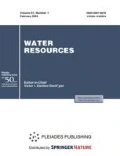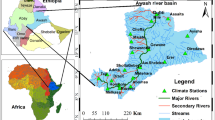Abstract
The lack of long term observed data is the main challenge in many simulation-based studies for identification of nutrient critical source areas (CSAs). This study explored the effect of calibration of the Soil and Water Assessment Tool (SWAT) on identification of nutrient CSAs and evaluated capability of this model for finding CSAs under the limited data condition. For this purpose, the Zrebar Lake watershed in Iran was used to assess the variations in total phosphorus and total nitrogen CSAs identified by both calibrated and uncalibrated SWAT models. In this study, a modified version of SWAT model was used for calibration the model considering observed lake water quality data and also for simulation of lake water quality and quantity interactions with the watershed management practices. The nutrient CSAs identified by calibrated and uncalibrated models showed that the irrigated farmlands were the main sources of nutrients discharged into the lake in which alfalfa, apple and tobacco were marked as the most polluting cultivations. It was also concluded that CSAs were not considerably different based on the calibrated and uncalibrated models. This validates the capabilities of SWAT on marking CSAs for areas with lack of long term observed data.





Similar content being viewed by others
REFERENCES
Abbaspour, K.C., Swat-Cup2: SWAT Calibration and Uncertainty Programs Manual Version 2, Department of Systems Analysis, Integrated Assessment and Modelling (SIAM), Eawag, Duebendorf, Switzerland: Swiss Federal Inst. Aquatic Sci. Technol., 2011.
Abbaspour, K.C., Johnson, C.A., and Van Genuchten, M.Th., Estimating uncertain flow and transport parameters using a sequential uncertainty fitting procedure, J. Vadouse Zone, 2004, vol. 3, no. 4, pp. 1340–1352.
Abbaspour, K.C., Yang, J., Maximov, I., Siber, R., Bogner, K., Mieleitner, J., Zobrist, J., and Srinivasan, R., Modelling hydrology and water quality in the pre-alpine/alpine Thur watershed using SWAT, J. Hydrol., 2007, vol. 333, nos. 2–4, pp. 413–430.
Arnold, J.G., Srinivasan, R., Muttiah, R.S., and Williams, J.R., Large-area hydrologic modeling and assessment: Part I, Model development, J. Am. Water Resour. Association (JAWRA), 1998, vol. 34, no. 1, pp. 73–89.
Arnold J.G. and Fohrer N., SWAT 2000: current capabilities and research opportunities in applied watershed modelling, Hydrol. Processes, 2005, vol. 19, no. 3, pp. 563–572.
Axinte, O., Badescu, I.S., Stroe, C., Neacsu, V., Bulgariu, L., and Bulgariu, D., Evolution of trophic parameters from Amara Lake, Environ. Eng. Manage. J., 2015, vol. 14, no. 3, pp. 559–565.
Bashiri, S., Akbarzadeh, A., Zarrabi, M., Yetilmezsoy, K., Fingas, M., and Moosakhaani, M., Using PCA combined SVM in the classification of eutrophication in Dez reservoir (Iran), Environ. Eng. Manage. J., 2016, in press.
Bracmort, K.S., Arabi, M., Frankenberger, J.R., Engel, B.A., and Arnold, J.G., Modeling long-term water quality impact of structural BMPs, Trans. ASABE, 2006, vol. 49, no. 2, pp. 367–474.
Chen, Y., Shuai, J., Zhang, Z., Shi, P., and Tao, F., Simulating the impact of watershed management of surface water quality protection: A case study on reducing inorganic nitrogen load at a watershed scale, Ecol. Engineering, 2014, vol. 62, pp. 61–70.
Comin, F.A., Sorando, R., Darwiche-Criado, N., Garcia, M., and Masip, A., A protocol to prioritize wetland restoration and creation for water quality improvement in agricultural watersheds, Ecol. Eng., 2014, vol. 66, pp. 10–18.
Epelde, A.M., Cerro, I., Sanchez-Perez, J.M., Sauvage, S., Srinisvaran, R., and Antiguedad, I., Application of the SWAT model to assess the impact changes in agricultural management practices on water quality, Hydrol. Sci. J., 2015, vol. 60, no. 5, pp. 825–843.
Fan, M. and Shibata, H., Simulation of watershed hydrology and stream water quality under land use and climate change scenarios in Teshio River watershed, northern Japan, Ecol. Indic., 2015, vol. 50, pp. 79–89.
Geza, M. and McCray, J.E., Effects of soil data resolution on SWAT model stream flow and water quality predictions, J. Environ. Manage., 2008, vol. 88, no. 3, pp. 393–406.
Ghebremichael, L.T., Veith, T.L., and Watzin, M.C., Determination of critical source areas for phosphorus loss: Lake Champlain basin, Vermont, Trans ASABE, 2010, vol. 53, no. 5, pp. 1595–1604.
Gong, Q., Wang, Y.P., and Dong, L.M., Multi-objective optimization of agricultural industrial structure based on water pollution control in Erhai basin in Yunnan province, Res. Agric. Moderniz., 2010, vol. 31, pp. 475–478.
Green, W.H. and Ampt, G.A., Studies on soil physics, 1. The flow of air and water through soils, J. Agric. Sci., 1911, vol. 4, no. 1, pp. 1–24.
Hernandez, E.A. and Uddameri, V., Selecting agricultural best management practices for water conservation and quality improvements using Atanassov’s intuitionistic fuzzy sets, Water Resour. Manage., 2010, vol. 24, no. 15, pp. 4589–4612.
Imani, S., Delavar, M., and Niksokhan, M.H., Periodical effects of land uses on water quality of Zrebar Lake, Iranian J. Geol., 2016, vol. 36.
Jamshidi, S., Niksokhan, M.H., and Ardestani, M., Surface water quality management using an integrated discharge permit and the reclaimed water market, Water Sci. Technol., 2014, vol. 70, no. 5, pp. 917–924.
Jamshidi, S., Niksokhan, M.H., Ardestani, M., and Jaberi, H., Enhancement of surface water quality using trading discharge permits and artificial aeration, Environ. Earth Sci., 2015. doi https://doi.org/10.1007/s12665-015-4663-5
Jha, M., Gassman, P.W., Secchi, S., Gu, R., and Arnold, J., Effect of watershed subdivision on SWAT flow, sediment, and nutrient predictions, J. Am. Water Resour. Assoc., 2004, vol. 40, no. 3, pp. 811–825.
Lam, Q.D., Schmalz, B., and Fohrer, N., The impact of agricultural Best Management Practices on water quality in a North German lowland catchment, Environ. Monit. Assess., 2011, vol. 183, nos. 1–4, pp. 351–379.
Liu, X., Chen, Q., and Zeng, Z., Study on nitrogen load reduction efficiency of agricultural conservation management in a small agricultural watershed, Water Sci. Technol., 2014, vol. 69, no. 8, pp. 1689–1696. doi https://doi.org/10.2166/wst.2014.076
Liu, M. and Lu, J., Predicting the impact of management practices on river water quality using SWAT in an agricultural watershed, Desalin. Water Treat., 2015, vol. 54, no. 9, pp. 2396–2409.
Luo, Q., Li, Y., Wang, K., and Wu, J., Application of the SWAT model to the Xiangjiang river watershed in subtropical central China, Water Sci. Technol., 2013, vol. 67, no. 9, pp. 2110–2116. doi https://doi.org/10.2166/wst.2013.100
Moriasi, D.N., Arnold, J.G., Van Liew, M.W., Bingner, R.L., Harmel, R.D., and Veith, T.L., Model evaluation guidelines for systematic quantification of accuracy in watershed simulations, Trans. ASABE, 2007, vol. 50, no. 3, pp. 885–900.
Neitsch, S.L, Arnold, J.G, Kiniry, J.R, Williams, J.R., and King, K.W., Soil and Water Assessment Tool, Theoretical Documentation, Version 2005, Temple, Tex.: Texas A&M Univ., Blacklands Res. Center, 2005. www.brc.tamus.edu/swat
Niraula, R., Kalin, L., Srivastava, P., and Anderson, C.J., Identifying critical source areas of nonpoint source pollution with SWAT and GWLF, Ecol. Modell., 2013, vol. 268, pp. 123–133.
Niraula, R., Kalin, L., Wang, R., and Srivastava, P., Determining nutrient and sediment critical source areas with SWAT: effect of lumped calibration, Trans. ASABE, 2012, vol. 55, no. 1, pp. 137–147.
Santhi, C., Arnold, J.G., White, M., Di Luzio, M., Kannan, N., Norfleet, L., Atwood, J., Kellogg, R., Wang, X., Williams, J.R., and Gerik, T., Effects of agricultural conservation practices on N loads in the Mississippi–Atchafalaya River Basin, J. Environ. Qual., 2013, vol. 43, no. 6, pp. 1903–1915. doi https://doi.org/10.2134/jeq2013.10.0403
Santhi, C., Arnold, J.G., Williams, J.R., Dugas, W.A., Srinivasan, R., Hauck, L.M., Validation of the SWAT model on a large river basin with point and nonpoint sources, J. Am. Water Resour. Assoc., 2001, vol. 37, no. 5, pp. 1169–1188.
Shang, X., Wang, X., Zhang, D., Chen, W., Chen, X., and Kong, H., An improved SWAT-based computational framework for identifying critical source areas for agricultural pollution at the lake basin scale, Ecol. Modell., 2012, vol. 226, pp. 1–10.
Sorooshian, S. and Gupta, V.K., Model calibration, in Computer Models of Watershed Hydrol., Water Resour. Publ., Singh, V.P., Ed., 1995, pp. 23–68.
Srinivasan, M.S., Gérard-Marchant, P., Tamiel, V., Gburek, W.J., and Steenhuis, T.S., Watershed scale modeling of critical source areas of runoff generation and phosphorus transport, J. Am. Water Resour. Assoc., 2005, vol. 41, no. 2, pp. 361–375.
Strauss, P., Leone, A., Ripa, M.N., Turpin, N., Lescot, M., Laplana, J., and Laplana, R., Using critical source areas for targeting cost-effective best management practices to mitigate phosphorus and sediment transfer at the watershed scale, British Soc. Soil Sci., 2007, vol. 23, Suppl. 1, pp. 144–153.
Tripathi, M.P., Panda, R.K., and Raghuwanshi, N.S., Identification and prioritisation of critical sub-watersheds for soil conservation management using the SWAT model, Biosyst. Eng., 2003, vol. 85, no. 3, pp. 365–379.
USDA SCS (Soil Conservation Service), SCS National Engineering Handbook. Section 4, Hydrology, Washington, DC, USA, 1972.
Yasin, H.Q. and Clemente, R.S., Application of SWAT model for hydrological and water quality modelling in Thachin River Basin, Thailand, Arabian J. Sci. Engineering, 2014, vol. 39, no. 3, pp. 1671–1684.
Zhukova, T.V., Long-term dynamics of phosphorus in the Narochanskie Lakes and factors determining it, Water Resour., 2013, vol. 40, no. 5, pp. 510–517.
Zou, Z.H., Yi, Y., and Sun, J.N., Entropy method for determination of weight of evaluating indicators in fuzzy synthetic evaluation for water quality assessment, J. Environ. Sci., 2006, vol. 18, no. 5, pp. 1020–1023.
Author information
Authors and Affiliations
Corresponding author
Additional information
The article is published in the original.
Rights and permissions
About this article
Cite this article
Somaye Imani, Delavar, M. & Niksokhan, M.H. Identification of Nutrients Critical Source Areas with SWAT Model under Limited Data Condition. Water Resour 46, 128–137 (2019). https://doi.org/10.1134/S0097807819010147
Received:
Published:
Issue Date:
DOI: https://doi.org/10.1134/S0097807819010147




